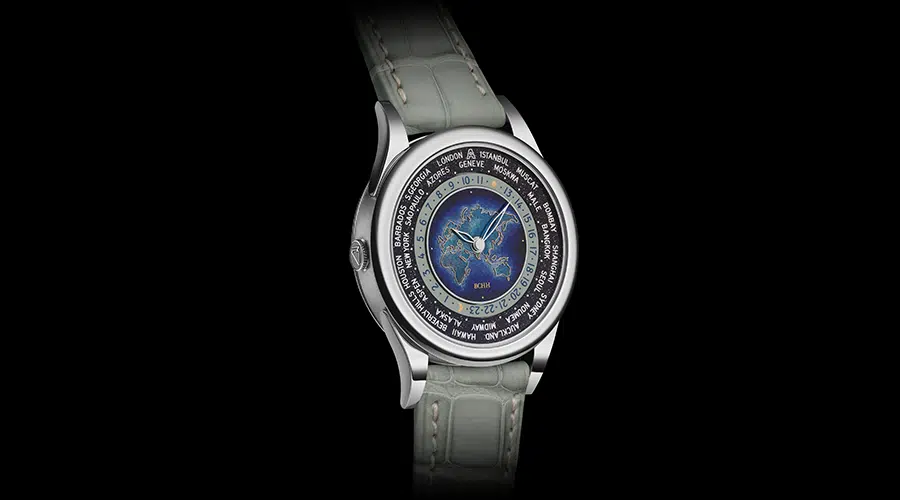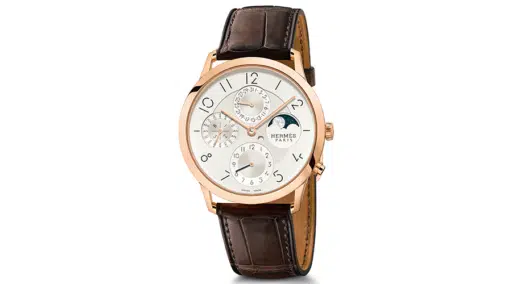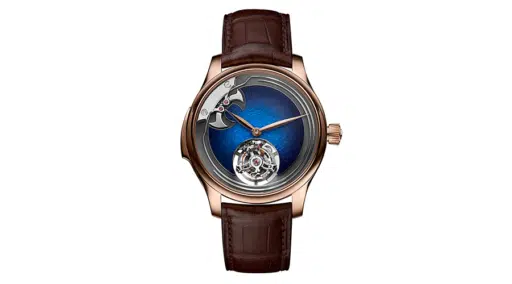World Timers: The Best Luxury World-Time Watches
No matter where you are, you’ll know the time around the world with a world-timer watch.

A world-time function is one of the most useful travel complications in a watch. World-time watches display the time in all of the main 24 time zones at a single glance. Louis Cottier, an independent Swiss watchmaker, invented world timers in the 1930s, and a handful of top brands, including Patek Philippe, produced stunning timepieces with the new complication. Today, you don’t need a watch to tell you the time around the world, so a world-time function is not a common complication, and only a handful of brands make them. However, they can be absolutely beautiful and are a wonderful way for a brand to show off its métiers d’art. Many watchmakers use the center of the dial as a canvas for miniature paintings of the earth or for beautiful guilloché.
How Do World Timers Work?
Classic world timers tell the local time using standard hour and minute hands and also show the 24 main time zones around the world (not the time zones offset by 30 minutes). Typically, world-time watches feature two rings/disks on the outside of the dial: one with a major city in each time zone, and one with a 24-hour scale. The 24-hour ring turns as time passes, making a full cycle every day. The hour that aligns with each city indicates the hour in that time zone. Some world timers use a hand that points to the city instead of a 24-hour ring, but the concept is the same.
Of course, watchmakers love to put their own spin on traditional movements and complications. Some companies, including Arnold & Son and Moritz Grossmann, don’t show the exact time around the world but take more artistic approaches to display the general time in a region.
Is It a World-time Watch or a World Timer?
Both are correct, and they mean the same thing. You’ll see watch brands use these two terms interchangeably, as we do. Some brands spell worldtimer as a single word.
Here is our selection of the best luxury world-time watches available today.
Patek Philippe Reference 5230P

Patek Philippe was one of the pioneers of world-time watches after their invention in the 1930s. Over the years, the brand has perfected the complication, even designing a patented time-change mechanism in 1999. The new Reference 5230P has a harmonious blue composition, including city and hour disks, central guilloché design, and strap. The P in the reference number stands for platinum, and this is the first time Patek Philippe has paired platinum with blue in its world-time watches. The 24-hour disk includes a day/night indication: The typical daylight hours between 6:30 a.m and 6:30 p.m are light colored, while the other half is dark. In addition, a sun is placed at noon, and a moon is at midnight. It’s easy to move the time-zone disk when you travel. A pusher at 10 o’clock controls the patented time-correction mechanism. Each push moves the world-time ring by one hour while the local time stays the same. The 38.5mm watch is powered by a thin automatic movement with a micro-rotor. The small rotor allows you to see more of the movement through the open caseback. Patek Philippe is also renowned for its world timers with cloisonné enamel dials that feature different regions of the world and for creating dedicated women’s world-time watches.
Andersen Genève Heures du Monde Celestial Voyager

Svend Andersen, the Danish watchmaker behind the independent Swiss watch brand Andersen Genève, specializes in world timers. He learned the craft as a watchmaker at Patek Philippe and brought his expertise to his own brand. Since the 1980s, he has released five different editions focusing on different métiers d’art. He uses a traditional two-ring design to display the time around the world and uses the inner dial for impressive métiers d’art — namely, guilloché and enamel painting. The Heures du Monde Celestial Voyager watch combines the two. The dial features a cloisonné enamel map showing part of Earth. The delicate gold wire outlines the continents, and the masterful enamel painting shows the land and ocean, turning from a pale to dark blue as the ocean becomes deep. To achieve this depth of color, a master enameller fires the dial more than 20 times in a kiln, risking cracks every time. The open caseback shows the finely finished movement, which has a rotor crafted from Andersen Genève’s signature blue gold. It features a guilloché scale motif. To make this limited-edition watch even more special, the brand uses aventurine as the city ring, noting it’s the first time that aventurine has been used in a world-time watch. Only seven pieces will be produced, and each one can be created to order, allowing clients to customize the names of the cities around the world.
Bovet Orbis Mundi

Bovet’s founder, Edouard Bovet, was known for his globe-trotting travels in the early 1800s. Today, the independent Swiss watch manufacture makes travel-time watches in his honor. Its Orbis Mundi watch uses disks for the cities and hours, but places the cities front and center instead of including a map. Bovet wanted to make the cities easier to read so that a tired jet-setting traveler would know the time at a glance, regardless of how many time zones they had recently moved. The result is a look unlike any other world timer out there. The disks are crafted from aventurine with a white minute track and Roman numerals for the hours, and the 24-hour ring and cities are in bold yellow. A small power-reserve indicator peeks out beneath; the watch has an impressive seven days of power. At 6 o’clock, it shows the seconds in an unusual way: There is a 20-second aventurine dial and a three-arm rotating seconds hand.
Moritz Grossmann Universalzeit

This unusual watch from independent German watch brand Moritz Grossmann isn’t a true world timer that tells the time in all 24 time zones, but it has an inventive movement that has never been done before. Universalzeit, which means “universal time” in German, shows seven time zones at once. Local time is indicated by the central hour and minute hands, and six apertures within a map of Earth show the time in one city. At first glance, the featured cities might seem random. Why pick Phoenix over Los Angeles or New York to represent the time in North America? Moritz Grossmann selected cities that don’t participate in Daylight Savings Time so the time is synced throughout the year. While you’ll have to do a little more math to tell the time in places that aren’t pictured, it’s easy enough to do if you have a basic sense of geography and time zones. Each aperture is placed at the exact city coordinates on the map, which includes longitude and latitude lines, as well. It features an in-house movement designed for this watch. It’s simple to change just the local time using a crown at 10 o’clock. The crown at 3 o’clock controls local time and the time in the apertures. The watch comes in a rather large 44.5mm stainless steel case.
Arnold & Son Globetrotter

Another more poetic world-time watch is the Globetrotter from independent Swiss watch brand Arnold & Son. The 45mm watch has a high, domed sapphire glass that contains a three-dimensional map of the northern hemisphere as seen from the North Pole. A striking gold bridge arches above the blue lacquered dial to secure the globe. The bridge is crafted from a single piece of solid gold and beautifully polished. The world time is indicated on a clear 24-hour sapphire disk that encircles the northern hemisphere map. It doesn’t have city disks or longitude lines, so you need to draw imaginary lines up to the sapphire hour disk to estimate the time. As time passes, the map slowly rotates. In order to accommodate the dome-shaped map, the Globetrotter doesn’t have traditional hour and minute hands. Instead, there are two small red arrows. The smaller points to the hours, the longer one to minutes. The indices, hands, and outline of the map are coated in Super-Luminova, so even the continents glow in the dark. While the world-time function isn’t the most legible of the watches featured here, it’s an interesting take on a world-time complication and telling time.
Chopard L.U.C Time Traveler One Black

This world timer from Chopard has a sleek, all-black look that is perfect for minimalists. It features shades of gray and black on four different disks. Instead of having the local 12-hour time on the outside of the dial, Chopard puts the cities on the outside. Inside that, there’s the 24-hour disk to indicate travel time, there’s a 12-hour disk for local time, and Chopard adds a date function on the inner disk. The 42mm watch is crafted from ceramized titanium, which is ultralight and can withstand the rigors of travel without getting scratched.






